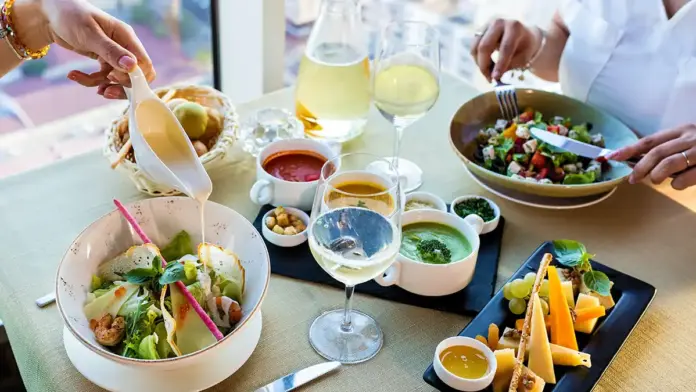
A remarkable phenomena has evolved in the constantly changing world of culinary arts, where innovation and tradition collide: the fusion of traditional herbs with contemporary food.
This magical combination, sometimes referred to as “culinary alchemy,” has altered not only the tastes and scents of foods but also opened the door for the addition of unusual components. Professional chefs have been interested in cannabis and its derivative, CBD, which are altering gourmet experiences in the foodservice and restaurant industries and reshaping menus.
A Historical Odyssey of Herbs in Cuisine
Throughout time, culinary practices from all cultures have used herbs to enhance flavors, give dishes depth, and create a feeling of harmony. Herbs have been essential in developing culinary symphonies that tickle the senses, from the scented cilantro in Mexican food to the fragrant basil in Italian cuisine. Ancient Egyptians, Greeks, and Romans cultivated gardens bursting with a variety of aromatic plants because they understood the culinary and therapeutic benefits of herbs.
Cannabis and CBD: From Stigma to Stardom
Cannabis has evolved from the stigma and prohibition to a place of intrigue and acceptance amid the resurgence of traditional herbs. Cannabis has a long history of culinary and medical use that predates its association with recreational use. The plant, for instance, held a holy place as a sacrament in religious rites in India and was employed as a curative herb in ancient China.
CBD (cannabidiol), a non-psychoactive component of cannabis, has recently attracted a lot of attention due to its conceivable health advantages. CBD is a desirable alternative for incorporation in culinary creations because it lacks the euphoric properties of its counterpart, THC (tetrahydrocannabinol).
Cannabis and CBD in Modern Gastronomy
Professional chefs and restaurateurs have embraced cannabis and CBD as ingredients that provide a fresh dimension to their culinary offerings as a result of the wave of cannabis legalization spreading throughout numerous countries. It requires a thorough understanding of doses, flavor profiles, and guest preferences to include these ingredients into recipes.
Kratom: One of the Fascinating Ancient Herbs
Kratom, a lesser-known herb compared to basil or thyme, has an intriguing history of its own. Native to Southeast Asia, it has been used for centuries for its medicinal and recreational properties. Among the various strains of kratom, “Gold Bali” and “Red Bali” stand out as popular choices with distinct characteristics. Gold Bali is revered for its relaxing and euphoric effects, while Red Bali is known for its potent pain-relieving properties. Both strains have their unique appeal, and enthusiasts often debate which one is superior for specific needs. As with other ancient herbs, the tale of Gold Bali vs. Red Bali continues to be an enchanting part of culinary alchemy, where nature’s treasures surprise us with their secrets.
 The Art of Infusion: Elevating Flavors and Experiences
The Art of Infusion: Elevating Flavors and Experiences
By incorporating cannabis and CBD into oils, sauces, and tinctures, professional chefs have unlocked the potential of these two substances. They produce adaptable bases this way that may be used in both savory and sweet meals. The subtle earthy overtones and depth of taste that these infusions provide go well with a variety of dishes, from meats to vegetables.
Culinary Cannabidiol: Creating Balance on Plates
Dishes created for diners who are wellness-conscious now include CBD, which is supposed to have healing benefits. Chefs have skillfully added CBD to recipes that are meant to encourage relaxation and lessen tension. These masterpieces demonstrate the skill of mixing flavor and wellness, from CBD-infused beverages that go with a multi-course meal to desserts that provide a pleasant conclusion.
High Dining: Redefining the Cannabis Experience
A new trend known as “high dining” is emerging in places where cannabis use is legal. High-end eateries offer painstakingly created tasting menus with meals infused with cannabis and skillfully paired wines and spirits. This well crafted experience demonstrates how cannabis has the potential to be a chic and tasteful component of gourmet dining.
Understanding the Issues and Challenges
Although there is great promise for using cannabis and CBD in food, there are some challenges as well. Chefs must strike a compromise between regulatory obligations and customer expectations because there are many different rules controlling the use of these ingredients. Precise dosing is necessary to preserve the culinary experience risk-free and enjoyable without adverse effects. Furthermore, it is crucial to educate clients on the advantages of cannabis and CBD in order to foster an informed and friendly dining atmosphere.
Culinary Alchemy in the Future: A Fusion of Custom and Innovation
The culinary world is always evolving, and the inclusion of CBD and cannabis on menus reflects the fusion of age-old traditions and cutting-edge science. New methods and flavor combinations will definitely develop as more chefs experiment with these ingredients, transforming the culinary landscape.
The development of cannabis- and CBD-infused products has the potential to draw customers from a range of demographics in the broader context of the foodservice and restaurant business. Diners seeking out novel experiences, health advantages, or just a variation from the norm are drawn to these inventive menus.
Conclusion
“Culinary Alchemy: Ancient Herbs and Modern Cuisine” tells the story of how herbs, once used solely as garnishes, have now taken center stage in a culinary renaissance. The resurgence of classic components like CBD and cannabis can be used to illustrate the transition from ancient civilizations to current cuisine. Professional chefs are developing immersive dining experiences that bridge the past and the present using their knowledge and innovation, producing a legacy of flavors that endure.
As the culinary sector pushes limits and forges new paths, the combination of cannabis and CBD forces us to reconsider our dining experiences. Through comprehensive experimentation, careful consideration of dosages, and a profound awareness of flavor nuances, chefs are transforming meals into sensory masterpieces and leaving a lasting mark on the culinary arts.
Grace Hawkins is a full time content writer who loves to write and covers a vast niche. He has been closely following the Industry trends for quite some time . He has been in the writing field for 8+ years. He loves running and hanging out with his family. Also, he loves doing Yoga to maintain a healthy lifestyle. You can reach Grace via email at grace.hawkins@thecbdglobal.net

























